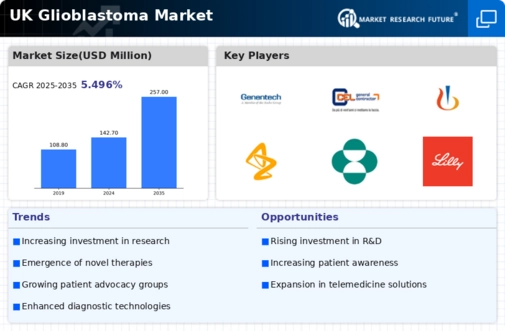Increasing Incidence Rates
The glioblastoma market is influenced by the rising incidence rates of glioblastoma in the UK. Recent statistics indicate that the age-standardized incidence rate for glioblastoma has increased by approximately 2.5% annually over the past decade. This trend is concerning, as glioblastoma remains one of the most aggressive forms of brain cancer, with a poor prognosis. The growing number of diagnosed cases is expected to create a surge in demand for treatment options, including surgical interventions, chemotherapy, and novel therapies. As healthcare systems adapt to manage this increasing burden, the glioblastoma market is poised for growth, with pharmaceutical companies focusing on developing new therapies to address this urgent need.
Growing Investment in Biotechnology
Investment in biotechnology is a key driver of the glioblastoma market in the UK. Venture capital funding for biotech firms focused on glioblastoma research has seen a substantial increase, with investments reaching over £200 million in the past year alone. This influx of capital is facilitating the development of innovative therapies, including gene therapies and targeted treatments. As biotechnology companies strive to bring new solutions to market, the glioblastoma market is expected to grow significantly. The emphasis on research and development in this sector not only enhances treatment options but also attracts further investment, creating a positive feedback loop that supports ongoing innovation.
Advancements in Diagnostic Technologies
The glioblastoma market in the UK is experiencing a notable shift due to advancements in diagnostic technologies. Enhanced imaging techniques, such as MRI and PET scans, are enabling earlier and more accurate detection of glioblastoma. This is crucial, as early diagnosis significantly improves treatment outcomes. The integration of artificial intelligence in imaging analysis is also gaining traction, potentially increasing diagnostic accuracy by up to 30%. As a result, healthcare providers are better equipped to identify glioblastoma at earlier stages, which may lead to a higher demand for innovative treatment options. Consequently, the glioblastoma market is likely to expand as more patients are diagnosed and seek advanced therapies, driving growth in this sector.
Collaboration Between Academia and Industry
The glioblastoma market is benefiting from increased collaboration between academic institutions and the pharmaceutical industry. Research partnerships are fostering innovation in treatment approaches, including immunotherapy and personalized medicine. These collaborations often lead to clinical trials that explore novel therapeutic strategies, which are essential for addressing the complexities of glioblastoma. In the UK, several universities are actively engaged in research that aims to translate laboratory findings into clinical applications. This synergy not only accelerates the development of new therapies but also enhances the overall understanding of glioblastoma biology. Consequently, the glioblastoma market is likely to expand as new insights lead to effective treatment modalities.
Regulatory Support for Innovative Treatments
Regulatory bodies in the UK are increasingly supportive of innovative treatments for glioblastoma, which is positively impacting the glioblastoma market. Initiatives such as the Early Access to Medicines Scheme (EAMS) allow patients to access promising therapies before they receive full regulatory approval. This approach encourages pharmaceutical companies to invest in research and development of novel glioblastoma treatments. Furthermore, the UK government has committed to enhancing the regulatory framework to expedite the approval process for breakthrough therapies. As a result, the glioblastoma market is likely to witness an influx of new treatment options, fostering competition and potentially improving patient outcomes.

















Leave a Comment